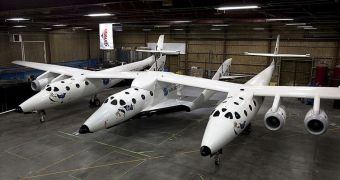Engineering teams at private space company Virgin Galactic are currently working very hard on getting their suborbital spacecraft ready to fly commercially, with paying passengers. Though that has not yet materialized, the corporation is already eying orbital flights, but keeps mum about it.
The SpaceShipTwo – WhiteKnightTwo combo appears the be the recipe for success at Virgin. The system works rather simply, and the results show.
The WhiteKnightTwo carried the smaller spacecraft, containing a crew of two and a handful of passengers, to high altitudes above the Earth's surface, where a locking system is opened, releasing the SpaceShipTwo.
Powered by a rocket motor, the smaller craft is propelled to even higher attitudes, where the effects of microgravity begin to be felt. After spending a few minutes in these conditions, the aircraft returns to Earth by gliding, and lands on a special runway in California.
This approach is already in advanced stages of testing, with Virgin Galactic planning to rent a seat on such a voyage for about $200,000, starting in mid-2011 or so, Space reports.
But the company is not content with only bringing suborbital space flight to the people. It also wants to achieve orbital capabilities, which is to say they want to be able to reach low-Earth orbit (LEO) on a regular basis.
“Obviously, we want to move on to orbital after we've got suborbital under our belts, and maybe even before that,” says UK billionaire Sir Richard Branson, the founder and president of Virgin Galactic.
The challenges associated with orbital flights are monumental. A lot of thrust is needed to increase a spacecraft's speed, so that it can travel a full orbit around the Earth, but this implies using more fuel.
In turn, doing so increases the weight of the vessel, which means that even more thrust is needed. Additionally, descending from orbital altitudes creates a lot of friction on account of reentry speeds, which push temperatures up, and may destroy spacecrafts.
This was unfortunately proven in 2003, when all seven crew aboard the space shuttle Columbia were lost during reentry, when a small tile in their orbiter's heat shield was damaged during take-off.
But officials at Virgin, Branson included, are not deterred by these difficulties. They announce plans to start developing the required technology as soon as possible, and say that they even want to compete for a NASA contract to deliver supplies to the International Space Station.
“Virgin Galactic is going to put forward proposals, and we plan to start work on an orbital program quite quickly,” Branson said at the October 22 dedication of Spaceport America.
Lockheed Martin, Boeing, SpaceX and the Sierra Nevada Corporation are the main competitors Virgin will have to face in securing NASA contracts, and also in conducting space tourism.
“We'll start with suborbital flights into space, we're then dreaming about trying to move on to orbital, and dreaming about, you know, looking at maybe having hotels in space one day, dreaming about maybe having intercontinental flights,” Branson adds.
“And if you don't dream you don't achieve anything. We try to inspire our engineers and technicians to make dreams become realities,” he concludes.

 14 DAY TRIAL //
14 DAY TRIAL //